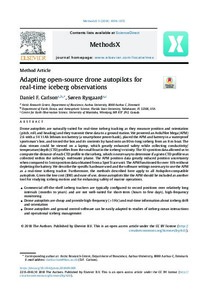| dc.contributor.author | Carlson, Daniel F. | |
| dc.contributor.author | Rysgaarda, Søren | |
| dc.coverage.spatial | Arctic Region | en_US |
| dc.date.accessioned | 2021-03-21T21:14:09Z | |
| dc.date.available | 2021-03-21T21:14:09Z | |
| dc.date.issued | 2018 | |
| dc.identifier.citation | Carlson, D.F. and Rysgaard, S. (2018) Adapting open-source drone autopilots for real-time iceberg observations,
MethodsX, 5, pp.1059-1072. DOI: https://doi.org/10.1016/j.mex.2018.09.003. | en_US |
| dc.identifier.uri | http://hdl.handle.net/11329/1528 | |
| dc.identifier.uri | http://dx.doi.org/10.25607/OBP-1026 | |
| dc.description.abstract | Drone autopilots are naturally suited for real-time iceberg tracking as they measure position and orientation
(pitch, roll, and heading) and they transmit these data to a ground station. We powered an ArduPilot Mega (APM)
2.6 with a 5V 11 Ah lithium ion battery (a smartphone power bank), placed the APM and battery in a waterproof
sportsman’s box, and tossed the box and its contents by hand onto an 80 m-long iceberg from an 8 m boat. The
data stream could be viewed on a laptop, which greatly enhanced safety while collecting conductivity/
temperature/depth (CTD) profiles from the small boat in the iceberg’s vicinity. The 10 s position data allowed us to
compute the distance of each CTD profile to the iceberg, which is necessary to determine if a given CTD profile was
collected within the iceberg’s meltwater plume. The APM position data greatly reduced position uncertainty
when compared to 5 min position data obtained from a Spot Trace unit. The APM functioned for over 10 h without
depleting the battery. We describe the specific hardware used and the software settings necessary to use the APM
as a real-time iceberg tracker. Furthermore, the methods described here apply to all Ardupilot-compatible
autopilots. Given the low cost ($90) and ease of use, drone autopilots like the APM should be included as another
tool for studying iceberg motion and for enhancing safety of marine operations.
- Commercial off-the-shelf iceberg trackers are typically configured to record positions over relatively long
intervals (months to years) and are not well-suited for short-term (hours to few days), high-frequency
monitoring
- Drone autopilots are cheap and provide high-frequency (>1 Hz) and real-time information about iceberg drift
and orientation
- Drone autopilots and ground control software can be easily adapted to studies of iceberg-ocean interactions
and operational iceberg management | en_US |
| dc.language.iso | en | en_US |
| dc.rights | Attribution 4.0 International | * |
| dc.rights.uri | http://creativecommons.org/licenses/by/4.0/ | * |
| dc.subject.other | Drone | en_US |
| dc.subject.other | Iceberg tracking | en_US |
| dc.subject.other | Iceberg drift | en_US |
| dc.title | Adapting open-source drone autopilots for real-time iceberg observations. | en_US |
| dc.type | Journal Contribution | en_US |
| dc.description.refereed | Refereed | en_US |
| dc.format.pagerange | pp.1059–1072 | en_US |
| dc.identifier.doi | https://doi.org/10.1016/j.mex.2018.09.003 | |
| dc.bibliographicCitation.title | MethodsX | en_US |
| dc.bibliographicCitation.volume | 5 | en_US |
| dc.description.sdg | 14.A | en_US |
| dc.description.eov | Sea ice | en_US |
| dc.description.maturitylevel | TRL 7 System prototyping demonstration in an operational environment (ground or space) | en_US |
| dc.description.bptype | Manual (incl. handbook, guide, cookbook etc) | en_US |
| obps.contact.contactname | Daniel F. Carlson | |
| obps.contact.contactemail | danfcarlson@bios.au.dk | |
| obps.resourceurl.publisher | https://www.sciencedirect.com/science/article/pii/S2215016118301456?via%3Dihub | en_US |
 Repository of community practices in Ocean Research, Applications and Data/Information Management
Repository of community practices in Ocean Research, Applications and Data/Information Management

